=================================================================================
Figure 1171a shows the Ar (argon) ion sputtering yield of copper (Cu) at Ar beam energies from to 0 to 5 keV.

| Figure 1171a. Ar ion sputtering yield of Cu at Ar beam energies from to 0 to 5 keV. [1-5] |
Figure 1171b shows the Ar (argon) ion sputtering yield of GaAs at Ar beam energies below 100 kV.
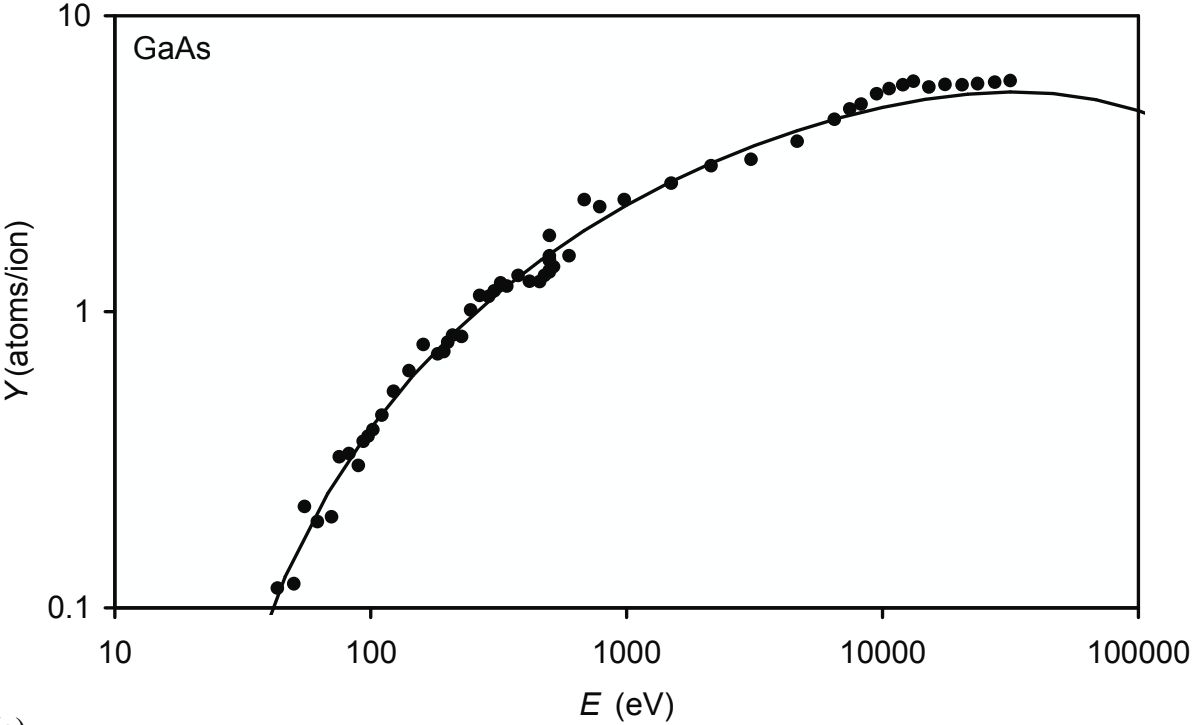
| Figure 1171b. Ar ion sputtering yield of GaAs at Ar beam energies below 100 keV. [9] |
Figure 1171c shows the Ar ion sputtering yield of various materials at Ar beam energies of 1 and 5 keV, indicating the trend of the yield variations versus the atomic numbers.
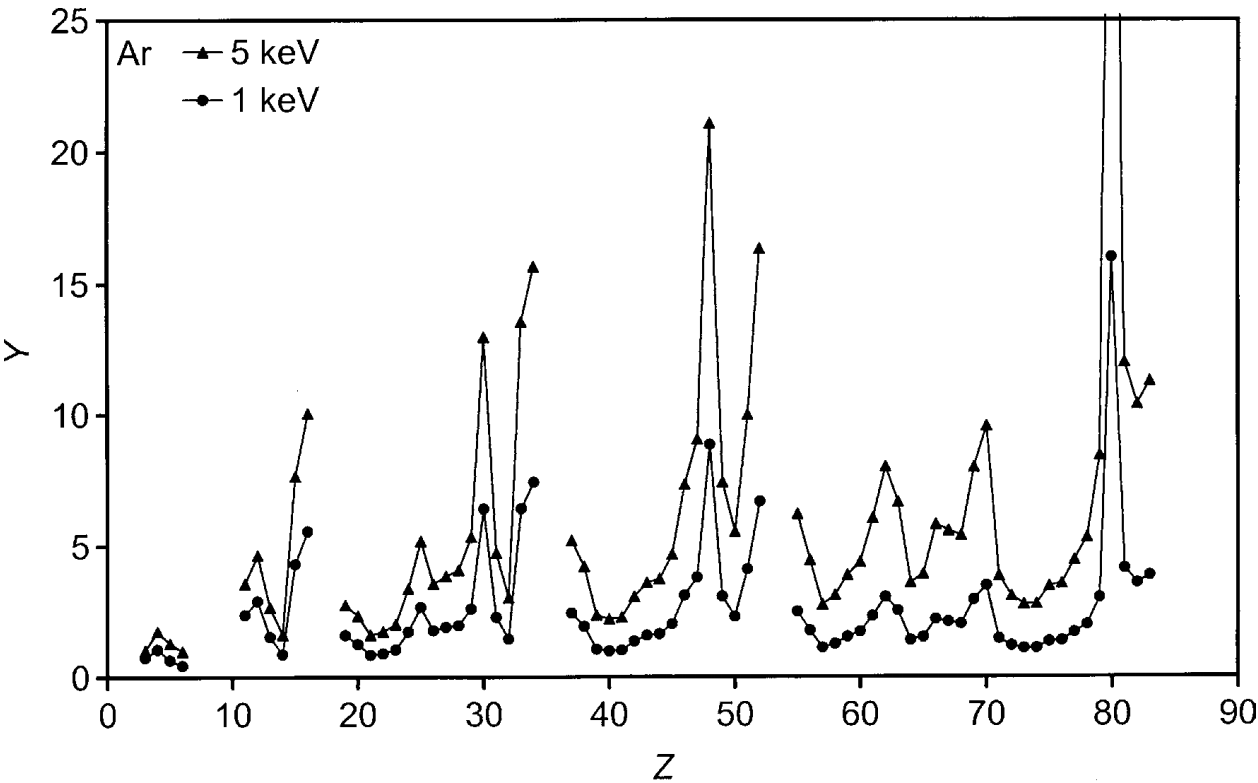
| Figure 1171c. Ar ion sputtering yield of various materials (Z: atomic number) at Ar beam energies of 1 and 5 keV. [6] |
Figure 1171c shows the quantified Ar fraction remaining in the surface layers after sputtering the samples with 7 keV argon ions at 35° to the surface normal.
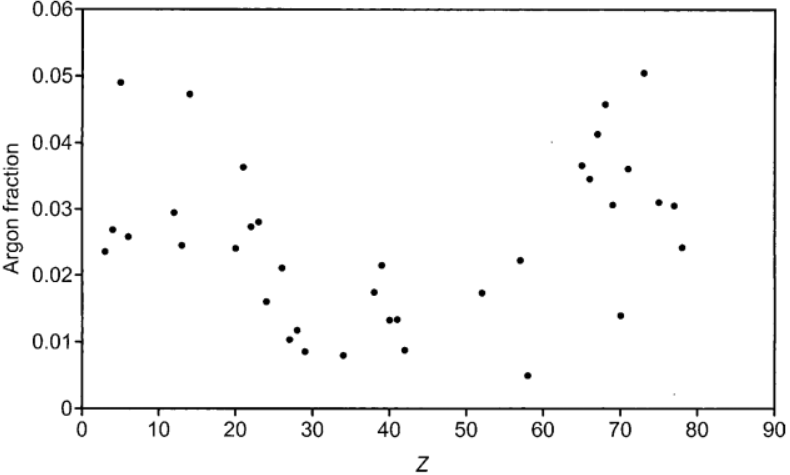
| Figure 1171c. Quantified Ar fraction remaining in the surface layers after sputtering the samples with 7 keV argon ions at 35° to the surface normal. [7,8] |
The sputter yield is also a function of sputtering angle, which is referenced to the sample normal. When the sputtering angle increases from zero, the sputter yield increases at the beginning. As the sputtering angle is increased further, the sputtering yield reaches a maximum value, and then it starts to decrease at larger sputtering angles since the incident ions can not efficiently transfer energy to the surface atoms of the sample.
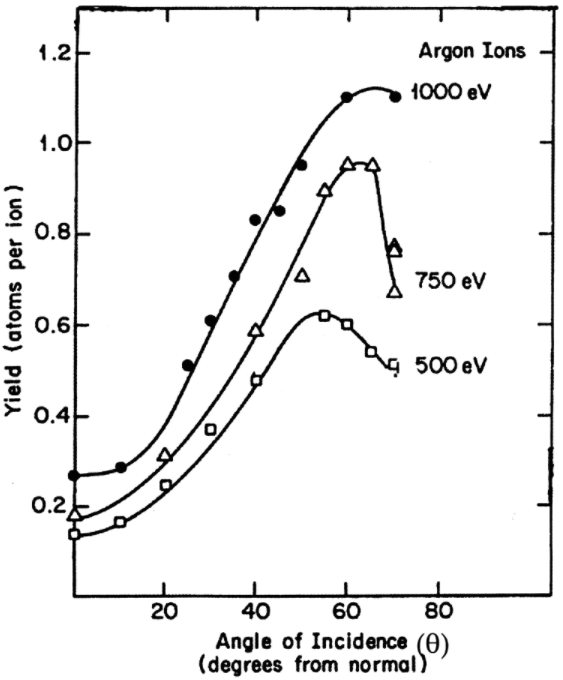
| Figure 1171d. Sputter yield measurements for diamond as a function of sputtering angle for 500, 750, and
1000 eV Ar ions. [10] |
In Ar milling on structured materials, the different milling rates of the materials in the structure can cause roughness of milled surfaces, which is well-known curtaining effect. Figure 1171e shows the milling rate difference between Si and SiO2 as a function of Ar beam energy. In practice, such milling rate difference needs to be minimized.
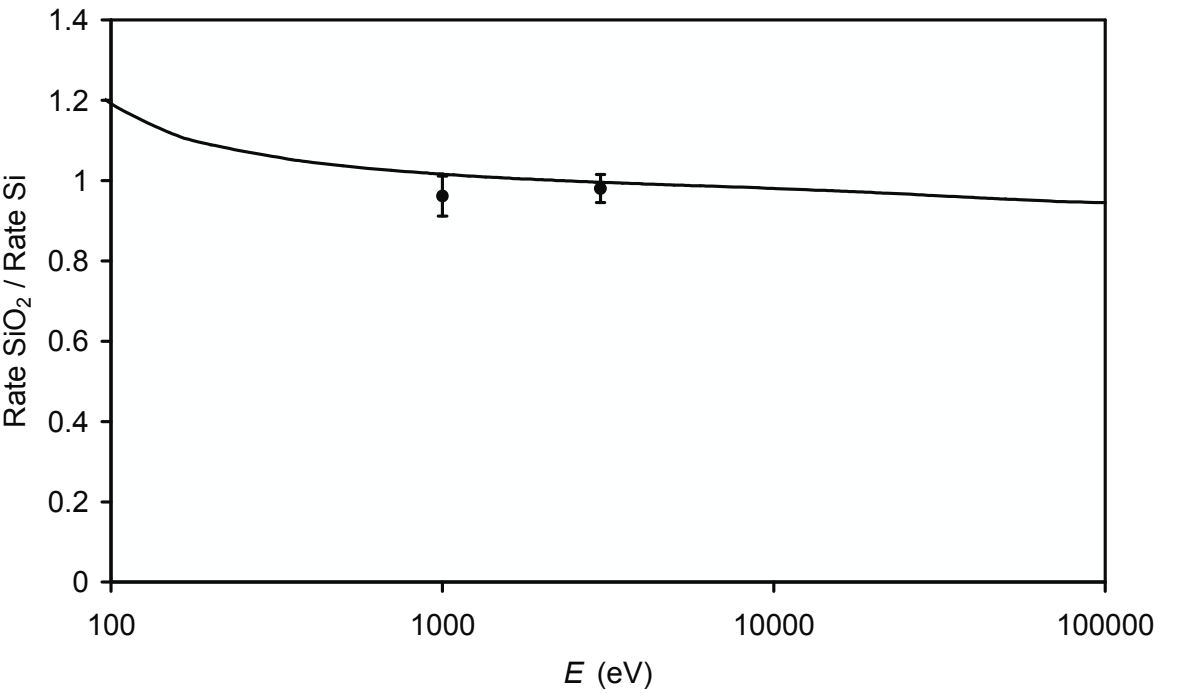
| Figure 1171e. Milling rate difference between Si and SiO2 as a function of Ar beam energy. [9] |
| Table 1171. Examples of Ar (argon) ion sputtering yields on different material surfaces. The incident angle is the angle of incidence with respect to target normal. |
| Atomic number |
|
Ar ion sputtering yields (atoms/ion for single elements or molecules/ion for compounds)
|
Note |
| Voltage (kV) |
0.5 |
1 |
2 |
3 |
4 |
5 |
5.6 |
10 |
20 |
50 |
100 kV |
|
| Angle |
0 degree |
|
| a-SiO2 |
|
|
|
0.8 |
0.91 |
0.92 |
1.05 |
1.4 |
1.7 |
1.2 |
|
|
| Al2O3 |
|
|
|
0.37 |
0.43 |
0.5 |
0.9 |
0.66 |
0.78 |
0.52 |
|
|
| GaAs |
0.5 |
1.5 |
|
|
|
|
|
|
|
|
4 |
|
| MgO |
|
|
|
1.6-1.9 |
|
|
0.82 |
2.6 |
3.40 |
|
|
|
| PbO-SiO2 |
|
|
|
|
|
2.0 |
2.64 |
|
|
|
|
|
| Ta2O5 |
|
0.26 |
0.36 |
0.43 |
0.45 |
|
|
|
|
|
|
|
| TiO2 |
|
|
|
|
|
|
0.9 |
|
|
|
|
|
| 1 |
H |
|
|
|
|
|
|
|
|
|
|
|
|
| 2 |
He |
|
|
|
|
|
|
|
|
|
|
|
|
| 3 |
Li |
|
|
|
|
|
|
|
|
|
|
|
|
| 4 |
Be |
|
|
|
|
|
|
|
|
|
|
|
|
| 5 |
B |
|
|
|
|
|
|
|
|
|
|
|
|
| 6 |
C |
|
|
|
|
|
|
|
|
|
|
|
|
| 7 |
N |
|
|
|
|
|
|
|
|
|
|
|
|
| 8 |
O |
|
|
|
|
|
|
|
|
|
|
|
|
| 9 |
F |
|
|
|
|
|
|
|
|
|
|
|
|
| 10 |
Ne |
|
|
|
|
|
|
|
|
|
|
|
|
| 11 |
Na |
|
|
|
|
|
|
|
|
|
|
|
|
| 12 |
Mg |
|
|
|
6.1 |
8.0 |
8.3 |
|
9.0 |
9.3 |
9.0 |
|
|
| 13 |
Al |
|
|
|
2.9 |
3.1 |
3.1 |
|
3.8 |
4.0 |
3.5 |
|
|
| 14 |
Si |
|
|
|
1.2 |
1.4 |
1.7 |
|
1.8 |
2.0 |
1.8 |
|
|
| 15 |
P |
|
|
|
|
|
|
|
|
|
|
|
|
| 16 |
S |
|
|
|
|
|
|
|
|
|
|
|
|
| 17 |
Cl |
|
|
|
|
|
|
|
|
|
|
|
|
| 18 |
Ar |
|
|
|
|
|
|
|
|
|
|
|
|
| 19 |
K |
|
|
|
|
|
|
|
|
|
|
|
|
| 20 |
Ca |
|
|
|
|
|
|
|
|
|
|
|
|
| 21 |
Sc |
|
|
|
|
|
|
|
|
|
|
|
|
| 22 |
Ti |
|
|
|
|
|
|
|
|
|
|
|
|
| 23 |
V |
|
|
|
|
|
|
|
|
|
|
|
|
| 24 |
Cr |
|
|
|
|
|
|
|
|
|
|
|
|
| 25 |
Mn |
|
|
|
|
|
|
|
|
|
|
|
|
| 26 |
Fe |
|
|
|
|
|
|
|
|
|
|
|
|
| 27 |
Co |
|
|
|
|
|
|
|
|
|
|
|
|
| 28 |
Ni |
|
|
|
|
|
|
|
|
|
|
|
|
| 29 |
Cu |
1.8 |
2.8 |
3.8 |
4.6 |
5.1 |
5.4 |
|
|
|
|
|
|
| 30 |
Zn |
|
|
|
|
|
|
|
|
|
|
|
|
| 31 |
Ga |
|
|
|
|
|
|
|
|
|
|
|
|
| 32 |
Ge |
|
|
|
|
|
|
|
|
|
|
|
|
| 33 |
As |
|
|
|
|
|
|
|
|
|
|
|
|
| 34 |
Se |
|
|
|
|
|
|
|
|
|
|
|
|
| 35 |
Br |
|
|
|
|
|
|
|
|
|
|
|
|
| 36 |
Kr |
|
|
|
|
|
|
|
|
|
|
|
|
| 37 |
Ru |
|
|
|
|
|
|
|
|
|
|
|
|
| 38 |
Sr |
|
|
|
|
|
|
|
|
|
|
|
|
| 39 |
Y |
|
|
|
|
|
|
|
|
|
|
|
|
| 40 |
Zr |
|
|
|
|
|
|
|
|
|
|
|
|
| 41 |
Nb |
|
|
|
|
|
|
|
|
|
|
|
|
| 42 |
Mo |
|
|
|
|
|
|
|
|
|
|
|
|
| 43 |
Tc |
|
|
|
|
|
|
|
|
|
|
|
|
| 44 |
Ru
|
|
|
|
|
|
|
|
|
|
|
|
|
| 45 |
Rh |
|
|
|
|
|
|
|
|
|
|
|
|
| 46 |
Pd |
|
|
|
|
|
|
|
|
|
|
|
|
| 47 |
Ag |
|
|
|
|
|
|
|
|
|
|
|
|
| 48 |
Cd |
|
|
|
|
|
|
|
|
|
|
|
|
| 49 |
In |
|
|
|
|
|
|
|
|
|
|
|
|
| 50 |
Sn |
|
|
|
|
|
|
|
|
|
|
|
|
| 51 |
Sb |
|
|
|
|
|
|
|
|
|
|
|
|
| 52 |
Te |
|
|
|
|
|
|
|
|
|
|
|
|
| 53 |
I |
|
|
|
|
|
|
|
|
|
|
|
|
| 54 |
Xe |
|
|
|
|
|
|
|
|
|
|
|
|
| 55 |
Cs |
|
|
|
|
|
|
|
|
|
|
|
|
| 56 |
Ba |
|
|
|
|
|
|
|
|
|
|
|
|
| 57 |
La |
|
|
|
|
|
|
|
|
|
|
|
|
| 58 |
Ce |
|
|
|
|
|
|
|
|
|
|
|
|
| 59 |
Pr |
|
|
|
|
|
|
|
|
|
|
|
|
| 60 |
Nd |
|
|
|
|
|
|
|
|
|
|
|
|
| 61 |
Pm |
|
|
|
|
|
|
|
|
|
|
|
|
| 62 |
Sm |
|
|
|
|
|
|
|
|
|
|
|
|
| 63 |
Eu |
|
|
|
|
|
|
|
|
|
|
|
|
| 64 |
Gd |
|
|
|
|
|
|
|
|
|
|
|
|
| 65 |
Tb |
|
|
|
|
|
|
|
|
|
|
|
|
| 66 |
Dy |
|
|
|
|
|
|
|
|
|
|
|
|
| 67 |
Ho |
|
|
|
|
|
|
|
|
|
|
|
|
68
|
Er |
|
|
|
|
|
|
|
|
|
|
|
|
69
|
Tm |
|
|
|
|
|
|
|
|
|
|
|
|
70
|
Yb |
|
|
|
|
|
|
|
|
|
|
|
|
71
|
Lu |
|
|
|
|
|
|
|
|
|
|
|
|
72
|
Hf |
|
|
|
|
|
|
|
|
|
|
|
|
73
|
Ta |
|
|
|
|
|
|
|
|
|
|
|
|
74
|
W |
|
|
|
|
|
|
|
|
|
|
|
|
75
|
Re |
|
|
|
|
|
|
|
|
|
|
|
|
76
|
Os |
|
|
|
|
|
|
|
|
|
|
|
|
77
|
Ir |
|
|
|
|
|
|
|
|
|
|
|
|
78
|
Pt |
|
|
|
|
|
|
|
|
|
|
|
|
79
|
Au |
|
|
|
|
|
|
|
|
|
|
|
|
80
|
Hg |
|
|
|
|
|
|
|
|
|
|
|
|
81
|
Tl |
|
|
|
|
|
|
|
|
|
|
|
|
82
|
Pb |
|
|
|
|
|
|
|
|
|
|
|
|
83
|
Bi |
|
|
|
|
|
|
|
|
|
|
|
|
84
|
Po |
|
|
|
|
|
|
|
|
|
|
|
|
85
|
At |
|
|
|
|
|
|
|
|
|
|
|
|
86
|
Rn |
|
|
|
|
|
|
|
|
|
|
|
|
87
|
Fr |
|
|
|
|
|
|
|
|
|
|
|
|
88
|
Ra |
|
|
|
|
|
|
|
|
|
|
|
|
89
|
Ac |
|
|
|
|
|
|
|
|
|
|
|
|
90
|
Th |
|
|
|
|
|
|
|
|
|
|
|
|
| 91 |
Pa |
|
|
|
|
|
|
|
|
|
|
|
|
| 92 |
U |
|
|
|
|
|
|
|
|
|
|
|
|
| Reference |
|
|
|
|
|
|
[11] |
|
|
|
|
|
[1] N. Laegried, G.K. Wehner, J. Appl. Phys. 32 (1961) 365.
[2] G.K. Wehner, in: A.W. Czanderna (Ed.), Methods of
Surface Analysis, Elsevier, New York, 1975, p. 5.
[3] C.H. Weijsenfeld, Philips Res. Rep. (Suppl. 2) (1967).
[4] H. Oechsner, Appl. Phys. 8 (1975) 185.
[5] A.L. Southern, W.R. Willis, M.T. Robinson, J. Appl.
Phys. 34 (1963) 153.
[6] M.P. Seah, An accurate semi-empirical equation for sputtering yields, II: for neon, argon and xenon ions, Nuclear Instruments and Methods in Physics Research B 229 (2005) 348–358.
[7] M.P. Seah, I.S. Gilmore, S.J. Spencer, J. Electron Spectrosc. 120 (2001) 93.
[8] M.P. Seah, I.S. Gilmore, S.J. Spencer, Surf. Interface
Anal. 31 (2001) 778.
[9]
M P Seah and T S Nunney, Sputtering yields of compounds using argon ions, Journal of Physics D: Applied Physics, 43, 25, 253001, 2010.
[10] T. J. Whetten, A.A. Armstead, T. A. Grzybowski, A. L. Ruo, J. Vac. Sci. Technol. A 2 (1984) 477.
[11] H. Bach, J. Non-Cryst. Sol. 102 (1988) 36.
|